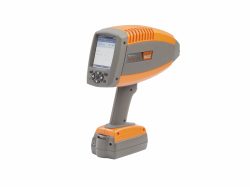ASD TerraSpec® Halo mineral identifier used to advance investigation of Life On Mars
*EDIT* Please note that this instrument has been discontinued by the manufacturer therefore is no longer available.
The ASD TerraSpec® Halo Mineral Identifier manufactured by Analytik partner Malvern Panalytical is being used to advance the investigation into life on Mars. The instrument is used for testing planetary field geology and mineralogy at sites in Arizona and Utah.

The ASD TerraSpec® Halo Mineral Identifier has been selected and used in multiple research projects aimed at expanding planetary exploration. This is as a result of the wealth of compositional information VIS-NIR-SWIR (visible-near infrared-short-wave infrared) spectroscopy can provide. The recent research projects selected the ASD handheld VIS-NIR-SWIR full range (350 to 2500nm) spectrometer to be utilised for the collection, analysis and interpretation of geological and mineralogical data. Mineralogical variations are significant because geochemical differences contain clues regarding whether a geologic environment was habitable or capable of preserving evidence of prior life. Without in-situ VIS-NIR-SWIR data, there could be missed critical information for scientific missions and interpretations.
“It is exciting to see the TerraSpec Halo contributing towards the advancement of planetary field geology research,” said Katherine Macchiarola, Marketing Director – Americas at Malvern Panalytical. “With NASA ramping up to go back to the Moon, to Mars and beyond, there’s a need for people to be well versed in planetary field geology,” said Dr. Ulyana Horodyskyj, scientist and co-teacher of Project PoSSUM’s citizen-science course. “The best we can do, at the moment, is study extreme environments on Earth that are going to be the most similar to Mars.”
A NASA-sponsored research project selected the ASD TerraSpec Halo to maximize the speed, efficiency and scientific return of Mars rover sample collection. The program used the spectrometer to simulate the function of the Mars Science Laboratory (MSL), ChemCam and Mars 2020 rover SuperCam. During the research project, the TerraSpec Halo allowed for rapid data acquisition of in-situ outcrops, similar to the data gathered by Mars rovers, and allowed the rover operations team to rapidly traverse the field site near Salt Lake City, Utah, maximizing the number of data points gathered.
Project PoSSUM (Polar Suborbital Science in the Upper Mesosphere), an astronautics research and education program studying our upper atmosphere and its role in changing global climate, allowed student researchers to use the ASD TerraSpec Halo to gather spectral measurements at the San Francisco Volcanic Field in northern Arizona and identify alteration minerals. This is key for when scientists and astronauts eventually do get back to the Moon or go to Mars, and are looking for traces of water.

Malvern Panalytical’s ASD TerraSpec Halo mineral identifier is an all-in-one full-range (350-2500nm) VIS-NIR-SWIR spectrometer that allows users to immediately identify minerals with a simple pull of a trigger. Performing a non-destructive contact measurement, the instrument delivers rapid mineral identification that significantly speeds scientific research and mining industry exploration efforts, increases efficiency, improves analysis and decision making, and ultimately saving time and money.
This article is based on the report by Malvern Panalytical.


